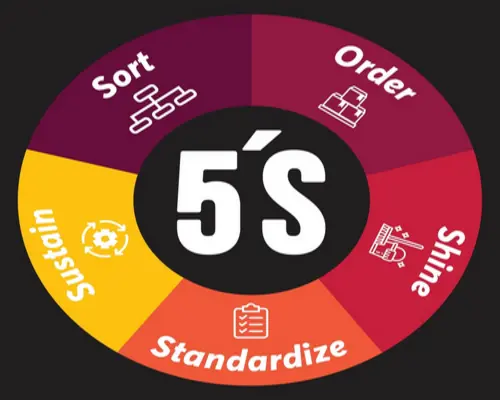Imagine working in an organization that was not clean and organized. What happens? You cannot work effectively, which results in lower production. Moreover, a congested and unorganized workplace makes it difficult to detect abnormalities and issues. For this reason, an organization adopts the 5s technique. The 5S method in Six Sigma aims to reduce waste while boosting productivity by maintaining a clean workstation and utilizing visual signals for improving performance.
5s is one of the most popular and fundamental elements of Lean Manufacturing. It is an innovative management approach that encourages lean thinking and paves the road for the firm to embrace lean concepts. Additionally, it is regarded as a more useful and practical strategy for improving processes, products, or error detection. Since sophistication in any business is characterized by organization and cleanliness everyone must be aware of the 5s in Lean Six Sigma.

What are the 5S in Six Sigma?
In essence, the 5s concept is a Japanese industrial housekeeping concept that has evolved into an organizational philosophy for continuous development. The 5S method is a strategy to set up a workplace such that it is safe, effective, and efficient. It aims to create a clean, uncluttered atmosphere that helps individuals to do their tasks quickly. Furthermore, it engages in frontline process teams while concentrating on improving everyday work.
5S was adopted from Japan and popularised by Taichi Ohno (designer of Toyota Production System) and Shigeo Shingo (associated with the concept of Poka-yoke). 5S is a collection of five S-based Japanese words. The English translations of all the terms also begin with the letter S. The 5s tool offers an easy-to-follow, step-by-step template that will help decrease waste and improve operations. The following are the five important steps involved in the 5S tool that must be performed in the right order or it might lead to subpar solutions.
Sort (Seiri)
The first S focuses on eliminating unnecessary items by separating the required tools, parts, and instructions. Practitioners sort through all the resources, tools, and equipment in the workspace to decide which are necessary and which should be eliminated. They employ the red tagging technique to eliminate unwanted things. Professionals place a red tag on a specific resource if they feel it needs to be entirely removed from the workspace. These red tagged items will be sent to a central holding location for later disposal, recycling, or redistribution.
Set in Order (Seiton)
Seiton is the process of organizing and setting things in a specific order at the workplace. It is based on the idea that there is a place for everything; everything has a place. After removing unnecessary tools and equipment, 5S practitioners systematically rearrange their workspace during this phase. They use labels, marks, or hints to make it simple to return items to their proper places and to identify missing items. This makes it easier and faster for the other staff members to find the needed materials.
Shine (Seiso)
The next step is to properly clean the workspace once all unwanted materials have been removed and the remaining stuff has been sorted. Practitioners should make daily attempts to maintain the new, well-organized workspace clean. This includes dusting, mopping, and keeping machines or tools in the workspace. They also make sure that the tools and equipment are organized and accessible to other staff members. In the IT industry, professionals implement this process by purging the file system of any unnecessary files and directories.
Standardize (Seiketsu)
The third pillar is to standardize the best practices in the work area after the initial three 5s have been implemented. Practitioners should plan daily maintenance and cleaning of the seiso, seiton, and seri. They combine related tasks in one location and designate a space in the workplace for that specific activity. Photographs and visual controls are used by practitioners to keep everything in order. They use audit checklists to review the status of the 5S implementation.
Sustain (Shitsuke)
The final phase emphasizes developing the habit of observing the first four S’s to implement and achieve 5S in the organization. Practitioners must make sure that all necessary tools, equipment, and resources are in place and in good condition throughout this stage. Accomplishments of the other pillars would not persist as long without the Sustain pillar. Signs and custom posters, newsletters, pocket manuals, management, and team check-ins, performance evaluations, and department tours are all examples of tools for maintaining 5S.
Conclusion:
Applying 5S allows businesses to not only enhance productivity and efficiency, but they also increase workplace safety. This further reduces training time for new employees. As a result, it is evident that 5s of six sigma plays a vital role in managing quality aspects in every organization. In order to understand in-depth about 5s professionals can opt for Lean Six Sigma Training. Attending such sessions also helps in gaining practical knowledge on implementing 5s in the organization.



